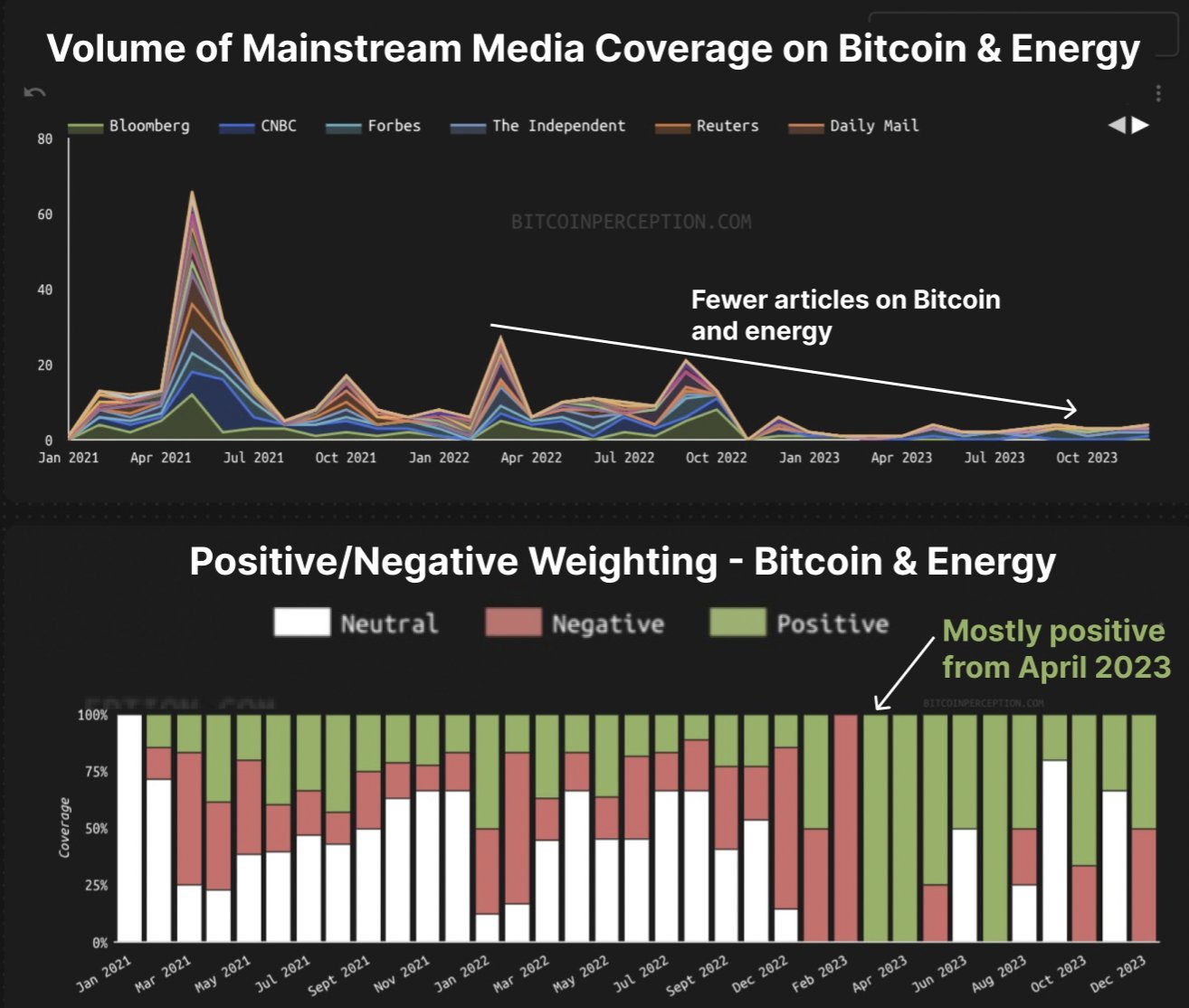Summary
- New data reveals confirmation that the mainstream narrative on Bitcoin and energy has changed.
- The first positive reporting month was April 2023.
Bitcoin and energy consumption reporting has been a sensitive press issue during the past years, but it looks like the narrative is shifting.
Marketing and Communications director at Blockstream, Fernando Nikolić, shared a message on his X account, highlighting that the Bitcoin and energy mainstream narrative is changing and now, there’s official data backing up the claim.
According to the latest reports, there is less mainstream coverage on Bitcoin and energy, a subject that used to make headlines during the past years, claiming that BTC consumes too much energy. Also, the latest coverage is now more likely to be positive, following the first positive reporting month – April 2023.
Data reveals, that since April of last year, there have been at least ten consecutive months with more than 50% positive reporting on Bitcoin and energy-related subjects.
The data presented in the charts goes back to 2011 and this is one of the most comprehensive views that was revealed regarding the narrative shift in operation.
The remaining detractors of Bitcoin mining on environmental grounds are reportedly in a fast-decreasing minority now. As the journalistic community tends to lag the scientific one, according to claims supported by the latest findings on X, the new data is very significant.
The important mainstream publications revealed by the latest data include Bloomberg, CNBC, Forbes, The Independent, Reuters, and Daily Mail, all of them showing a shift in reporting on Bitcoin and energy issues.
Bitcoin ETFs and BlackRock Helping the Narrative Shift
Bitcoin on-chain analyst, Willy Woo, also shared his opinion on the matter, posting that this is partly due to the US judicial system which forced the SEC’s hand to open up spot Bitcoin ETFs, “of which BlackRock was the clear winner who gets 15% shareholder vote of everything including the mainstream press.”
Bitcoin ETFs received approval for launch in the US at the beginning of 2024 and a few months ago, BlackRock’s Larry Fink was saying that their BTC ETF is the fastest-growing product in history.
July 1 was the fifth consecutive day in which the BTC ETFs in the US recorded inflows. Yesterday’s inflows totaled $129.45 million, according to new data from SoSoValue.
Bitcoin Uses 0.66% of the World’s Electricity
Woo has recently addressed the issue of Bitcoin and electricity via X, saying that the Bitcoin network is currently using approximately 0.66% of the world’s electricity.
He also explained that if the world continues accelerating its renewable energy rollout, Bitcoin will need to use more electricity to help balance the grid as more intermittent power from solar and wind comes online.
Woo said that 34% of the world’s electricity is lost by the grid before it reaches our homes, and BTC needs to balance the grid to prevent losses.
Bitcoin Miners Turn to Renewable Energy Sources
After being in the spotlight for more years regarding their Bitcoin mining operations, miners are shifting focus to renewable energy sources.
The best example in this regard is El Salvador, the first nation that adopted Bitcoin as a legal tender back in 2021 in order to promote financial inclusion and job creation, while facilitating remittances.
El Salvador turned to volcano energy to mine Bitcoin, using a geothermal power plant at Tecapa Volcano which can generate 102 megawatts of electricity of which 1.5 megawatts are reportedly used for mining Bitcoin, according to Reuters.
The innovative use of renewable energy in the country has proven itself to be successful, showing support for the highly criticized crypto mining sector that has seen intense scrutiny for its energy consumption.
According to data from Silvercrest Asset Management Group, an investment services provider, Bitcoin mining helps the world create new incentives to harness nature’s abundant potential energy.
